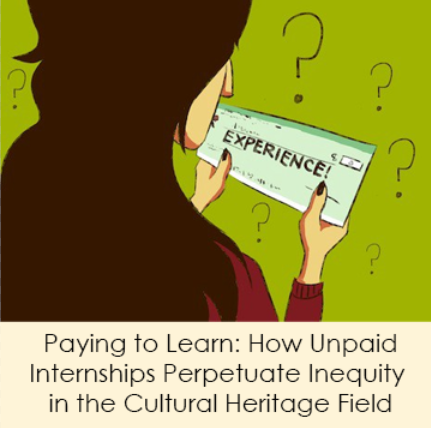
Like many other fields, entrance into the cultural heritage sector is generally dependent on a combination of education, training, and experience. Prospective students and recent graduates often must rely on internships and volunteer work to accrue the networks and necessary on-site experience to qualify them for jobs or positions in graduate programs designed for higher-level training.
However, research conducted by Intern Bridge has shown that of the available internships for the social sciences or arts and humanities, only 34% and 43% are paid internships, respectively. This means that the vast majority of opportunities are without financial support, making them volunteer positions. With internships being such an integral step into a career in this sector, we must understand how these opportunities can instead act as barriers to diversity and inclusion.
It is important to remember the fact that an internship with no pay does not mean that it also has no cost. An article by Money estimated the costs of an average summer internship at approximately $6,200 including food, housing, transportation, relocation, and other expenses (this number may vary depending on location). Additionally, though some unpaid opportunities offer university credit as “compensation,” students on internships may not be enrolled in enough credits to be eligible as full-time students, potentially impacting the requirements of a financial aid package (if they were able to receive financial aid in the first place). Recent graduates who have already completed their degrees have no need for these credits. Moreover, some universities will actually charge students a fee or percentage of tuition to remain enrolled as a student if they are not on campus, as indicated by a report by Demos.
These financial factors compound to create an almost insurmountable barrier for students and individuals from low-income backgrounds. And this hurdle, in turn, perpetuates the racial homogeneity of the cultural heritage field, as research from 2013 has found that working families headed by racial/ethnic minorities were twice as likely to be low-income as their white counterparts (additional Pew Research Center report found here). Therefore, to become a more inclusive and diverse field, we must address these fundamental blocks.
As we all move forward, we can begin by referencing some successful efforts being made to increase diversity in the cultural heritage field, and conservation in particular. The Andrew W. Mellon Opportunity for Diversity in Conservation provides opportunities and support for students and recent graduates of underrepresented minorities in conservation. Many universities and institutions have utilized Mellon grants to fund internships and fellowships targeted towards increasing diversity, including UCLA/ Getty. In 2018, the Association of Art Museum Directors instituted a Paid College Internship program for minority college students. Just this week, the Association of African American Museums announced a new fellowship for African Americans in the cultural sector to provide learning, job experience, and placement for Black Americans aspiring to cultural leadership.
#awareness #culturalheritage #internships #unpaidisunfair #equalopportunity
